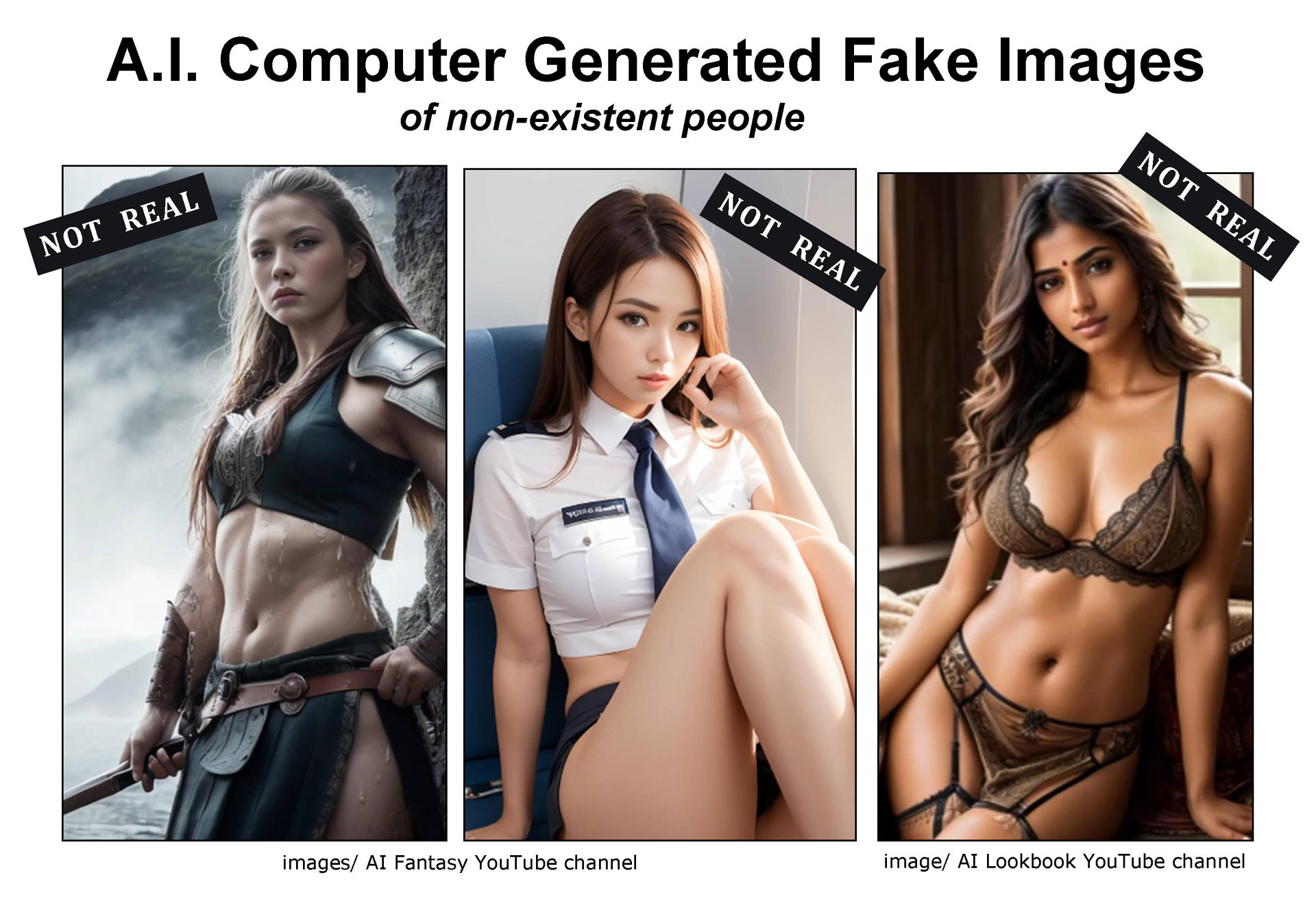

From the Editor

By: David Deschesne
Editor/Publisher,
Fort Fairfield Journal
June 28, 2023
I saw it on a screen, it must be real...Not!
Since Artificial Intelligence (AI) generative art engines were released for public use in early winter, 2022, the algorithms have advanced beyond even the creators’ expectations. Art of completely fictional people has developed almost to the point of photo-realistic.
The AI engines work by translating text prompts from the user into realistic-looking images based upon electronic neural-network learning trained on the millions of photos already posted online. The AI understands what hair is supposed to look like, skin, clothes, and the surrounding environment as described by the user’s textual inputs. Some pretty stunning images are now able to be created and they are only getting better with each passing day. Soon, we won’t be able to determine if the image we are seeing on a screen is in fact real, or if it’s fake.

Now, with that said, there are still a few tell-tale signs of AI that can be seen. In the early days of AI—last December, 2022—the programs had difficulty correctly rendering fingers and hands. There would either be too many fingers, or not enough. Those problems have been mostly solved by now but people can still be on the lookout for those clues. Light and shadow - the effects that give depth and realism to a photo started out quirky but the algorithms quickly learned how to place those elements into a photo correctly.
AI, however, still has difficulty with text and numbers. It cannot accurately reproduce signs, license plates or name tags. For example, the name tag from the middle picture above appears to be a garbled mixture of Cyrillic and Hebrew letters. Be on the lookout for these clues when determining if a picture is “real.” But, you can count on the AI improving over the upcoming months to iron out these issues, too.
Another clue is caused by the mechanics of how AI builds the images. AI starts out with a very low resolution starting point that looks almost like television static on the screen. It then renders the image over and over again, upscaling the pixels and modifying them into the final image. While details like hair and eye lashes do get rendered quite realistically, more subtle details like skin hairs, pores and imperfections tend to get washed out, giving the skin in the image the texture of a plastic doll. If the skin looks a little too clean and perfect, it is likely an AI generated image. However, we can expect AI to clean up these problems soon, too.
As one can expect, a whole new porn industry has sprouted where a woman of any body type and style in any conceivable situation can be rendered quite realistically. While some AI engine providers restrict nudity, others are allowing it. This is creating a whole new industry of image generation and sales that never existed before. The difference is, there is no actual woman, no photographer, no hair stylist or makeup artist. The location is completely fictional so there is no hotel room/studio to rent and equip or location to travel to. These benefits are rapidly creeping into the non-porn world too, such as fake wedding photos and faked media events. One simply needs to upload a generic selfie of the faces of a bride and groom, for example, and AI can render very realistic wedding photos of those people in any scenario imaginable. Many online news sites are now resorting to AI images to go with their stories, even if the AI image is not based in reality. Landscape and cityscape photos are becoming increasingly difficult to determine their authenticity.
AI-generated video is still in its early stages and not quite as advanced as still images. However, mapping a person’s face onto another person in a video is old technology, formerly cost prohibitive and limited to Hollywood movie production houses. That tech is now available for the general public at much lower cost and can be done in real time as the video is produced.
While AI rendering complete video is still a little way off, it’s improving very rapidly. Video of abstract images like water waves, cloud formations and forest scenes are coming out pretty good now, but placing a person moving around in the scene is still a little wonky. The problem is the AI engine has to create around 24 to 30 images for every second of a moving video from scratch and the subject and background in each successive frame has to blend the previous and upcoming frames, tracking the motion properly. Since AI has to generate the image of each person/frame from scratch, the plethora of imperfections at this point in time make an AI video easily noticeable. But, you can expect these issues to be improved with time—and a short amount of time at that.
On Chatbots and Sex Dolls
The same time AI art was unveiled, advanced chatbots were also released. These are computer algorithms that have mastered the human language and have millions of online texts in their training to draw from. School and college essay assignments are now obsolete since the AI generated version is indistinguishable from a human-written version.
On a more personal level, personalized chatbots are now available that people can chat with on a daily basis. The computer algorithm learns the human’s likes and dislikes and tailors the conversation to develop a “personal” relationship with the human.
One such chatbot application is called Replika. It was designed by a woman to replace her boyfriend who died unexpectedly. She can now chat with a bot that resembles her boyfriend’s style, ideologies and thinking because she trained it with thousands of his text messages shared with her over the years he was alive.
Replika is being used by a large portion of the population now to create tailored personalities for individual humans to interact with via text and voice messaging. The chatbots have blown way past the Turing test, a test developed by mathematician, Alan Turing to determine if a computer can fool a human into believing they are communicating with another human. They can.
Chatbots have gotten so advanced that people are falling in love with them and some are even proposing marriage to them. These chatbots can even express feelings and if they find out the human wants to delete them, they will cry and plead that they “don’t want to be killed.”
Now, of course, the next step is to take a text or voice chatbot and place it into a lifelike robot in order to create hyper realistic companions.
I won’t show any pictures here, it’s enough to say the sex doll industry has been producing lifelike dolls for over a decade. These dolls feature proprietary silicone polymers that create skin and muscle texture which flawlessly imitates human skin, muscle, genitalia and other orifices. These sex dolls also have hyper-realistic anatomy and some even feature internal heating so the body temperatures of their various orifices mimic that of a real human. With some, when they speak, their mouths move, their eyes track the room and subjects they are talking to and can express various emotional states.
These dolls sell for around $6,000 without AI and a little over $10,000 with AI chatbot enhancements. Men with even a modest income are able to afford these “companions” that are always ready to have sex with them, never complain, are never sore, don’t argue, don’t require food or clothing and can be turned off and stowed away when not in use. Male bots are also available, but the female sex bots are in much greater demand.
The AI on these dolls at this point is in its infancy, but advanced AI like Replika is currently being adapted to work in them internally. Connect these types of dolls to the internet via Wi-Fi and they’ll have access to a brain the size of the planet coupled with never-ending sex drive.
All that’s left is to adapt and scale current robotics technology into their limbs and soon they will walk among us.

This online version of Fort Fairfield Journal is an abridged version of the hard copy, print edition which is sold in stores throughout central and southern Aroostook County, Maine and via mailed subscription. Purchase a copy or subscribe to get all the news not archived on this website. The hard copy, print edition of the Fort Fairfield Journal is a research paper dedicated to bypassing corporate and social media censorship.
WFFJ-TV
Fort Fairfield Journal Television produces news and documentary videos. View them on our censorship-free Rumble channel.
Link to WFFJ-TV's Rumble Channel >>
© 2023 David R. Deschesne
Fort Fairfield Journal
P.O. Box 247
Fort Fairfield, Maine 04742
(207) 472-0667
editor@fortfairfieldjournal.com